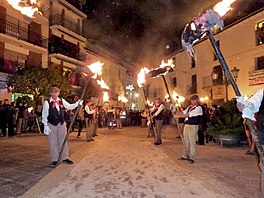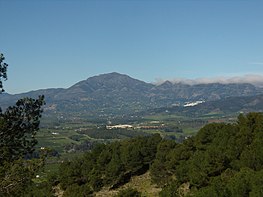Casarabonela
Casarabonela is a Spanish municipality in the province of Málaga, Andalusia. It is located in the center of the province, in the Sierra de las Nieves region. Declared a Biosphere Reserve by Unesco and integrated into the Sierra de las Nieves Natural Park and its surroundings. In 2016 it had a total population of 2,573 inhabitants.
History
The Casarabonela area was already inhabited since prehistoric times. There is evidence of the human presence in various sites of lithic workshops, burials and caves with everyday tools. The most important historical sites that have been found date from Roman times, when the city was called Castra Vinaria (Wine Castle).
With the arrival of the Arabs, most of the Roman monuments were respected, even Omar ibn Hafsún, who managed to conquer the city and used it as a defensive front for Bobastro, reinforced his fortress and changed the name of the town to Qasr Bunaira. In 922 the Caliphate of Córdoba manages to recover the city and reinforces it again against the rebels. These reinforcements in the fortifications made Casarabonela one of the last settlements to capitulate during the Reconquest, on June 2, 1485.
In 1574, Felipe II granted it the status of a town. After the expulsion of the Moors (1609-1614), most of the lands remained uninhabited and were repopulated by citizens from other areas of Andalusia and Extremadura.
In the year 1810, José Bonaparte spent the night in the city on his trip to Malaga.
Geography
Casarabonela is located on the western edge of the Valle del Guadalhorce region, entering the natural region of Ronda through Alcaparaín (1,200 m) and Prieta (1,521 m), until it approaches the Turón river on its border with the municipality of The Burg.
In the center of its municipal area, surrounded by olive groves and cereal fields, rises the peridotite outcrop of the Sierra de La Robla (563 m), which overlooks the rest of the formations of the Serranía and the pine forests. the fields of Zalea, in the heart of the Guadalhorce. limestone ground. Horticulture on terraces that produce fruit and vegetables.
Flag
Rectangular cloth, in proportion 2/3, divided horizontally into three parts of equal width, the upper green, the central white and the lower blue. Superimposed on the center of the cloth the municipal heraldic shield in its colors.
The colors of the flag are inspired by the landscape and culture of Casarabonela.
The blue of the water is at the base and in the foundations of the town and its flag. So important to welcome all the cultures that have settled here: Romans, Arabs and Christians. The underground water, along with that which flows from its springs and springs, waters the fertile orchards of Casarabonela.
Whitewashed houses and the Moorish labyrinth on the slopes of the mountains.
Green, nature, the fertile fields and the mountains of Sierra Prieta and Alcaparaín, which crown the view and the landscape of Casarabonela.
Politics and Administration
The political administration of the municipality is carried out through a City Council whose members are elected every four years by universal suffrage. The electoral census is made up of all residents registered in Casarabonela over the age of 18 and nationals of Spain and the other member states of the European Union. According to the provisions of the General Electoral Regime Law, which establishes the number of eligible councilors based on the population of the municipality, the Municipal Corporation of Casarabonela is made up of 11 councilors.
Municipal elections of 2007
After the municipal elections of 2007, the PSOE obtained an absolute majority with 6 councilors and 954 votes, the PP obtained 3 councilors and 429 votes and AGIC (Agrupación Independiente de Casarabonela) obtained 2 seats and 307 votes. By obtaining an absolute majority, the socialist party governed during this legislature.
2011 municipal elections
After the 2011 municipal elections, the PSOE won 5 seats and 759 votes, the PP 3 seats and 422 votes and AGIC 3 seats and 407 votes. As the socialist party did not obtain an absolute majority, PP and AGIC shared the legislature, governing for 2 years each.
2015 municipal elections
After the 2015 municipal elections, the PSOE obtained an absolute majority with 6 councilors and 815 votes, the PP 4 councilors and 480 votes and AGIC (Agrupación Independiente de Casarabonela) obtained 1 councilor and 222 votes. The socialist party with its absolute majority recovered the mayoralty of the municipality with Antonio Campos Campos as mayor.
Economy
Evolution of outstanding municipal debt
| Graphic of evolution of Living Debt of the City of Casarabonela between 2008 and 2019 |
 |
Living debt of the Town Hall of Casarabonela in thousands of Euros according to data from the Ministry of Finance and Ad. Public. |
Culture
Mora i Bravard Botanical Garden
Botanical garden dedicated to cactus and inaugurated in 2011, with more than 2,500 species adapted to live in arid areas. The collection of succulent plants was formed by Joan Mora and Edwige Bravard, a couple who developed their interest in these plants on the island of Majorca, until they moved to Andalusia in 1995 and established their collection in the current location of the garden in Casarabonela.
Popular festivals
- Passion: Palm Sunday nights, Monday and Holy Tuesday.
- May cruises: first Saturday of May.
- Flamenca Watch: first Saturday of July.
- Celebrations of Santiago Apostle: last weekend of July or first of August.
- Romería de la Virgen del Rosario: Saturday or Sunday closest to 13 September.
- Feast of the Virgin of the Rondeles: December 12th.
Crafts
Esparto grass articles, wooden articles, palm articles, pita articles, artistic ceramics, macramé, cattail chairs and saddlery.
Gastronomy
The best-known dish of Moorish gastronomy is pipeo, a pot cooked with lettuce and broad bean seeds, to which is added a mashed garlic and fried bread and served with bread tortillas. Likewise, the different ways of cooking rabbit and goat are very famous. In addition to sweets: oil cakes, almond cakes, wine donuts, biscuits, sweet potato dumplings, polvorones, mantecados, mostachones.
Holy Week
Good Friday: Brotherhood of the Servitas.
Public transport
Casarabonela is not formally integrated into the Malaga Area Metropolitan Transport Consortium, although there are intercity bus routes that operate in its territory. They can be consulted at the following link.
Contenido relacionado
3rd century
Juan Jose Rios
Balearic Islands

